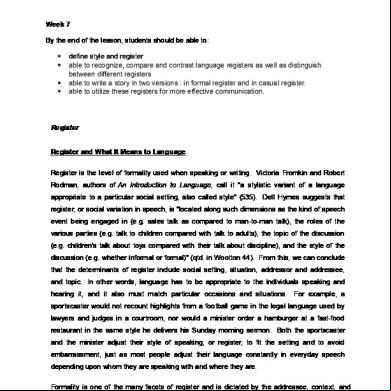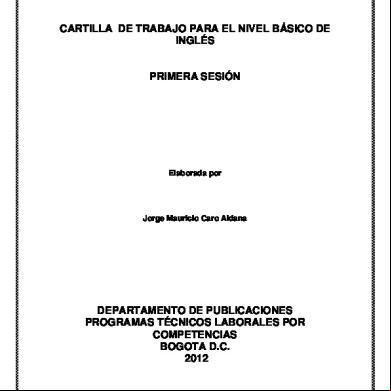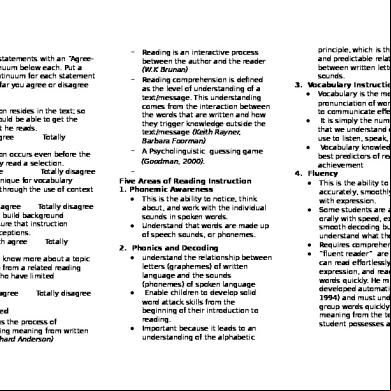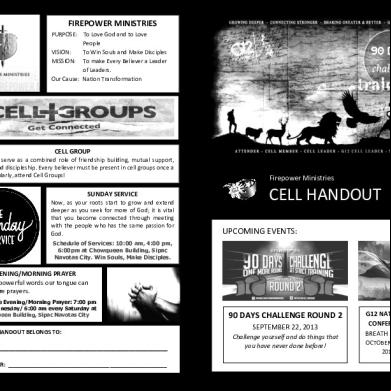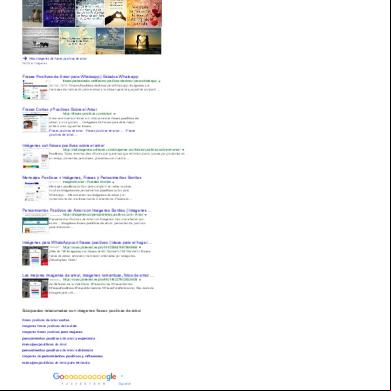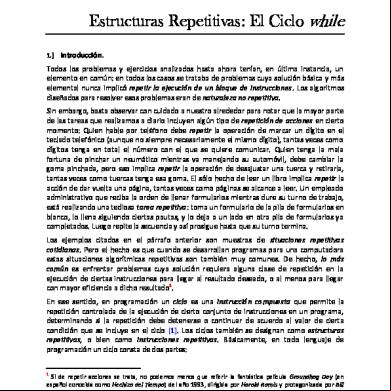Week 7_ Handout 1_style And (1) (1) 5g2c2w
This document was ed by and they confirmed that they have the permission to share it. If you are author or own the copyright of this book, please report to us by using this report form. Report 2z6p3t
Overview 5o1f4z
& View Week 7_ Handout 1_style And (1) (1) as PDF for free.
More details 6z3438
- Words: 2,370
- Pages: 11
GEC1033 – English for Effective Communication
Week 7 By the end of the lesson, students should be able to:
define style and able to recognize, compare and contrast language s as well as distinguish between different s able to write a story in two versions : in formal and in casual . able to utilize these s for more effective communication.
and What It Means to Language is the level of formality used when speaking or writing. Victoria Fromkin and Robert Rodman, authors of An Introduction to Language, call it "a stylistic variant of a language appropriate to a particular social setting, also called style" (535). Dell Hymes suggests that , or social variation in speech, is "located along such dimensions as the kind of speech event being engaged in (e.g. sales talk as compared to man-to-man talk), the roles of the various parties (e.g. talk to children compared with talk to adults), the topic of the discussion (e.g. children's talk about toys compared with their talk about discipline), and the style of the discussion (e.g. whether informal or formal)" (qtd. in Wootton 44). From this, we can conclude that the determinants of include social setting, situation, addressor and addressee, and topic. In other words, language has to be appropriate to the individuals speaking and hearing it, and it also must match particular occasions and situations. For example, a sportscaster would not recount highlights from a football game in the legal language used by lawyers and judges in a courtroom, nor would a minister order a hamburger at a fast-food restaurant in the same style he delivers his Sunday morning sermon. Both the sportscaster and the minister adjust their style of speaking, or , to fit the setting and to avoid embarrassment, just as most people adjust their language constantly in everyday speech depending upon whom they are speaking with and where they are. Formality is one of the many facets of and is dictated by the addressee, context, and
topic. When an individual speaks or writes in the formal mode, he or she uses Standard American English, which Fromkin and Rodman define as "an idealized dialect of English that is considered by some prescriptive grammarians to be the proper form of English" (537). Formal , seen more often in written language than in spoken, is used in the professional realm and when people are not familiar with each other. People tend to speak more informally when talking with family and friends. Non-standard American English, slang, and the frequent use of contractions can characterize informal . Formal and informal allow the speaker to use a variety of speech styles that can easily be switched to meet the needs of both the speaker and the listener. For example, a medical doctor does not use the same to address everyone he or she speaks to. A doctor may use an informal at home with family and friends, a more formal with patients that does not include medical jargon that the patient would not understand, and an even more formal with colleagues that may include medical jargon and words associated with the medical field. Many professionals such as doctors and lawyers have a jargon of their own that is not really slang. These are words commonly used in their profession and make them sound more credible to their peers. Just as formality determines , the subject matter dictates what kind of the speaker will use. A doctor is not going recite the steps of tying shoelaces to his four-year-old daughter in the same manner he would recite the procedures for conducting open-heart surgery. Language varies according to the situation and addressee, but it also varies according to the speaker's social class, ethnic group, age, and sex, as Peter Trudgill notes in Sociolinguistics: An Introduction to Language and Society (100). This explains why there are differences between professionals' and blue-collar workers' speech, African-Americans' and Italian Americans' speech, teenagers' and adults' speech, and men's and women's speech. The type of addressee determines what will be used. This change in , when the speaker shifts his or her to match the context, "corresponds to what Blom and Gumperz call situational switching" (Pride 28). For example, a teenage girl chatting on the phone with a classmate is speaking informally, using slang, and speaking non-standard English, and when she accepts an incoming call from her father's lawyer, she shifts her speaking style from informal to formal by speaking Standard American English and by leaving out slang and colloquialisms used by her and her friends. This kind of situational switching occurs naturally in the speech of most people and happens so quickly that the speaker usually does not have to make a conscious decision to
change his or her . Relevant Term
(Style): The level of formality used when speaking and writing. Most speakers of a language know how to use many dialects, using one with friends, another when on a job interview or presenting a report in class, and another with talking with family. These are situational dialects, also called s or styles.
Slang: An informal style of speech. Combining old words to elicit a more current meaning often creates slang . "Spaced out," "right on," "hang-ups," and "rip off" have all gained acceptances as slang . Slang may also introduce an entirely new word to the language; examples include "barf" and "poop." Finally, slang often ascribes totally new meanings to old words. Some examples of these type of slang words are as follows: grass/pot = marijuana, pig = police officer, sticks = legs. Words such as "rap," "cool," "dig," "stoned," and "split" have extended their semantic domain as well.
Jargon: Words peculiar to a professional realm, science, trade, or occupation. Words such as "ROM," "RAM," "morf," "modem," "bit," and "byte" were once computer jargon and only understood by computer technicians, but they are now understood by a large segment of the population.
Situational Switching: the act of changing one's to match the setting, situation, addressee, or topic.
Some Types of s
Formal : A type of that incorporates Standard American English and is used by professionals or in situations where people are not familiar with one another.
Informal : A type of used with more familiar people in casual conversation. In the informal style of , contractions are used more often, rules of negation and agreement may be altered, and slang or colloquialisms may be used. Informal also permits certain abbreviations and deletions, but they are rule
governed. For example, deleting the "you" subject and the auxiliary often shortens questions. Instead of asking, "Are you running in the marathon," a person might ask, "Running the marathon?"
Over-formal : A type of that can be characterized by the use of a false high-pitched nasal voice. For example, a woman might approach another woman whom she does not really like and ask her cordially in a high-pitched voice, "How are you doing?"
Motherese: A type of characterized by high-pitched, elongated sounds and "sing-song" intonation. It is used when people speak to infants, young children, or pets.
Reporting : A type of characterized by easily observable verbal and non-verbal cues: flat intonation, rapid rate of speech, relatively low pitch, absence of marked facial expressions, and gestures.
How to Study In their book Sociolinguistic Perspectives on , Douglas Biber and Edward Finegan provide an analytic framework to follow when studying . Biber begins with his definition of as being “a general cover term for all language varieties associated with different situations and purposes” (32).
The framework should include and distinguish between
characteristics of linguistic and non-linguistic factors and should use these differences for a classification of . The communicative characteristics of participants involved in the situation taking place must be taken into consideration, beginning with the addressor(s), which can be the writer or speaker. This will be a singular person; several people, as in a co-authored work; or institutional, as in departmental or government document. The addressee(s) will be singular, as in a dyadic conversation or a letter; plural, as in a classroom; or unenumerated, such as in a novel or a magazine. Next, a researcher must examine the relations between the addressor and addressee, taking into the social role each participant maintains. Age, occupation, and shared knowledge, whether on the topic and/or personal background, all play important parts in determining this relationship. In regards to relative status and power, it is necessary to
determine which one has the most power or if they share an equal status. The amount of interchange involved can be extensive, as in everyday typical conversation; extensive or moderate, such as in classroom lectures; or nonexistent, as in published materials or formal speeches. Furthermore, it should be established whether or not the participants share personal knowledge of each other’s background. When and where the communication takes place is referred to as setting. Biber identifies settings with a particular context of use or domain. He distinguishes six primary domains: “Business and workplace, education and academic, government and legal, religious, art and entertainment, and domestic/personal” (43). Within each of these areas, there exists a public and a private setting. Technology such as TV, radio, or any type of mass media can be used to represent or present these domains. It must be taken into that a difference among s may arise when the time of communication and place are shared, as in direct conversation in the presence of each other. Participants can share time and be familiar with, but not actually share place, as in a telephone conversation. Also, participants “can be familiar with, but not share, both time and place of communication (as in many letters), or be completely unaware of each other’s place and time (as in most kinds of expository writing)” (43). Careful attention must be given to the primary channel, or mode, of communication--usually writing or speech. Both channels may be used together, thereby becoming a mixed mode such as a written lecture. Other modes include drum talk, sign language, or Morse codes. Another characteristic of mode to be considered is its permanence factor. For speech--such as telephone conversations, face-to-face conversations, and television and radio broadcasts--the mode can be classified as recorded or transient. Because writing, published or unpublished, is a form of recording, it is thereby nearly always permanent, classified as transcribed, printed, taped, handwritten, e-mail, or other. How the addressor presents the information and how the addressee receives it should also be considered. Unlike writers, speakers lack the opportunity, “to plan, revise, and edit their texts as much as they wish” (43). In addition to this, the addressee is affected by comprehension circumstances such as self-imposed time constraints. Another factor important in differentiating among s is the different purposes, intents, and goals of the addressor. At one extreme are s that attempt to explain or describe facts. At
the other end of the spectrum are s that are completely fictional or overtly imaginative. Between these two extremes are a variety of s such as position papers, historical fiction, editorials, philosophical arguments, and theoretical position papers. As for purpose, Biber characterizes it along four parameters: “ ‘persuade’ (or sell), ‘transfer information’, ‘entertain’ (or edify), and reveal self" (44). Lastly, the topic or subject being discussed--whether popular, generalized, or specialized--needs to be considered. If the subject is specialized, it must be noted accordingly, examples being science, finances, politics, sports, and law. Through these parameters, a thorough study of and all of its affecting circumstances can be accomplished. Biber writes: “The primary goal of the framework is to specify the situational characteristics of s in such a way that the similarities and differences between any pair of s will be explicit” (41). By Ellen Hunt, Myra Jones, Rebecca Price, Claudia Walker, Lindsay Walker, Debra Williams Students, University of North Carolina at Pembroke Hunt, Ellen, et al. "." All American: Literature, History, and Culture. 1999. http://www.un.edu/home/canada/work/allam/1914-/language/.htm (*).
Language s There are five language s or styles. Each level has an appropriate use that is determined by differing situations. It would certainly be inappropriate to use language and vocabulary reserve for a boyfriend or girlfriend when speaking in the classroom. Thus the appropriate language depends upon the audience (who), the topic (what), purpose (why) and location (where). You must control the use of language s in order to enjoy success in every aspect and situation you encounter. 1.
Static
This style of communications RARELY or NEVER changes. It is “frozen” in time and content. e.g. the Pledge of Allegiance, the Preamble to the US Constitution, the Alma Mater, a bibliographic reference, laws . 2.
Formal
This language is used in formal settings and is one-way in nature. This use of language usually follows a commonly accepted format. It is usually impersonal and formal. A common format for this are speeches. e.g. sermons, rhetorical statements and questions, speeches, pronouncements made by judges, announcements. 3.
Consultative
This is a standard form of communications. s engage in a mutually accepted structure of communications. It is formal and societal expectations accompany the s of this speech. It is professional discourse. e.g. when strangers meet, communications between a superior and a subordinate, doctor & patient, lawyer & client, lawyer & judge, teacher & student, counselor & client, 4.
Casual
This is informal language used by peers and friends. Slang, vulgarities and colloquialisms are normal. This is “group” language. One must be member to engage in this . e.g. buddies, teammates, chats and emails, and blogs, and letters to friends.
5.
Intimate
This communications is private. It is reserved for close family or intimate people. e.g. husband & wife, boyfriend & girlfriend, siblings, parent & children. Rule of Language Use: One can usually transition from one language to an adjacent one without encountering repercussions. However, skipping one or more levels is usually considered inappropriate and even offensive. Source: Montano-Harmon, M. R. “Developing English for Academic Purposes” California State University, Fullerton. http://www.genconnection.com/English/ap/Languages.htm
Week 7 By the end of the lesson, students should be able to:
define style and able to recognize, compare and contrast language s as well as distinguish between different s able to write a story in two versions : in formal and in casual . able to utilize these s for more effective communication.
and What It Means to Language is the level of formality used when speaking or writing. Victoria Fromkin and Robert Rodman, authors of An Introduction to Language, call it "a stylistic variant of a language appropriate to a particular social setting, also called style" (535). Dell Hymes suggests that , or social variation in speech, is "located along such dimensions as the kind of speech event being engaged in (e.g. sales talk as compared to man-to-man talk), the roles of the various parties (e.g. talk to children compared with talk to adults), the topic of the discussion (e.g. children's talk about toys compared with their talk about discipline), and the style of the discussion (e.g. whether informal or formal)" (qtd. in Wootton 44). From this, we can conclude that the determinants of include social setting, situation, addressor and addressee, and topic. In other words, language has to be appropriate to the individuals speaking and hearing it, and it also must match particular occasions and situations. For example, a sportscaster would not recount highlights from a football game in the legal language used by lawyers and judges in a courtroom, nor would a minister order a hamburger at a fast-food restaurant in the same style he delivers his Sunday morning sermon. Both the sportscaster and the minister adjust their style of speaking, or , to fit the setting and to avoid embarrassment, just as most people adjust their language constantly in everyday speech depending upon whom they are speaking with and where they are. Formality is one of the many facets of and is dictated by the addressee, context, and
topic. When an individual speaks or writes in the formal mode, he or she uses Standard American English, which Fromkin and Rodman define as "an idealized dialect of English that is considered by some prescriptive grammarians to be the proper form of English" (537). Formal , seen more often in written language than in spoken, is used in the professional realm and when people are not familiar with each other. People tend to speak more informally when talking with family and friends. Non-standard American English, slang, and the frequent use of contractions can characterize informal . Formal and informal allow the speaker to use a variety of speech styles that can easily be switched to meet the needs of both the speaker and the listener. For example, a medical doctor does not use the same to address everyone he or she speaks to. A doctor may use an informal at home with family and friends, a more formal with patients that does not include medical jargon that the patient would not understand, and an even more formal with colleagues that may include medical jargon and words associated with the medical field. Many professionals such as doctors and lawyers have a jargon of their own that is not really slang. These are words commonly used in their profession and make them sound more credible to their peers. Just as formality determines , the subject matter dictates what kind of the speaker will use. A doctor is not going recite the steps of tying shoelaces to his four-year-old daughter in the same manner he would recite the procedures for conducting open-heart surgery. Language varies according to the situation and addressee, but it also varies according to the speaker's social class, ethnic group, age, and sex, as Peter Trudgill notes in Sociolinguistics: An Introduction to Language and Society (100). This explains why there are differences between professionals' and blue-collar workers' speech, African-Americans' and Italian Americans' speech, teenagers' and adults' speech, and men's and women's speech. The type of addressee determines what will be used. This change in , when the speaker shifts his or her to match the context, "corresponds to what Blom and Gumperz call situational switching" (Pride 28). For example, a teenage girl chatting on the phone with a classmate is speaking informally, using slang, and speaking non-standard English, and when she accepts an incoming call from her father's lawyer, she shifts her speaking style from informal to formal by speaking Standard American English and by leaving out slang and colloquialisms used by her and her friends. This kind of situational switching occurs naturally in the speech of most people and happens so quickly that the speaker usually does not have to make a conscious decision to
change his or her . Relevant Term
(Style): The level of formality used when speaking and writing. Most speakers of a language know how to use many dialects, using one with friends, another when on a job interview or presenting a report in class, and another with talking with family. These are situational dialects, also called s or styles.
Slang: An informal style of speech. Combining old words to elicit a more current meaning often creates slang . "Spaced out," "right on," "hang-ups," and "rip off" have all gained acceptances as slang . Slang may also introduce an entirely new word to the language; examples include "barf" and "poop." Finally, slang often ascribes totally new meanings to old words. Some examples of these type of slang words are as follows: grass/pot = marijuana, pig = police officer, sticks = legs. Words such as "rap," "cool," "dig," "stoned," and "split" have extended their semantic domain as well.
Jargon: Words peculiar to a professional realm, science, trade, or occupation. Words such as "ROM," "RAM," "morf," "modem," "bit," and "byte" were once computer jargon and only understood by computer technicians, but they are now understood by a large segment of the population.
Situational Switching: the act of changing one's to match the setting, situation, addressee, or topic.
Some Types of s
Formal : A type of that incorporates Standard American English and is used by professionals or in situations where people are not familiar with one another.
Informal : A type of used with more familiar people in casual conversation. In the informal style of , contractions are used more often, rules of negation and agreement may be altered, and slang or colloquialisms may be used. Informal also permits certain abbreviations and deletions, but they are rule
governed. For example, deleting the "you" subject and the auxiliary often shortens questions. Instead of asking, "Are you running in the marathon," a person might ask, "Running the marathon?"
Over-formal : A type of that can be characterized by the use of a false high-pitched nasal voice. For example, a woman might approach another woman whom she does not really like and ask her cordially in a high-pitched voice, "How are you doing?"
Motherese: A type of characterized by high-pitched, elongated sounds and "sing-song" intonation. It is used when people speak to infants, young children, or pets.
Reporting : A type of characterized by easily observable verbal and non-verbal cues: flat intonation, rapid rate of speech, relatively low pitch, absence of marked facial expressions, and gestures.
How to Study In their book Sociolinguistic Perspectives on , Douglas Biber and Edward Finegan provide an analytic framework to follow when studying . Biber begins with his definition of as being “a general cover term for all language varieties associated with different situations and purposes” (32).
The framework should include and distinguish between
characteristics of linguistic and non-linguistic factors and should use these differences for a classification of . The communicative characteristics of participants involved in the situation taking place must be taken into consideration, beginning with the addressor(s), which can be the writer or speaker. This will be a singular person; several people, as in a co-authored work; or institutional, as in departmental or government document. The addressee(s) will be singular, as in a dyadic conversation or a letter; plural, as in a classroom; or unenumerated, such as in a novel or a magazine. Next, a researcher must examine the relations between the addressor and addressee, taking into the social role each participant maintains. Age, occupation, and shared knowledge, whether on the topic and/or personal background, all play important parts in determining this relationship. In regards to relative status and power, it is necessary to
determine which one has the most power or if they share an equal status. The amount of interchange involved can be extensive, as in everyday typical conversation; extensive or moderate, such as in classroom lectures; or nonexistent, as in published materials or formal speeches. Furthermore, it should be established whether or not the participants share personal knowledge of each other’s background. When and where the communication takes place is referred to as setting. Biber identifies settings with a particular context of use or domain. He distinguishes six primary domains: “Business and workplace, education and academic, government and legal, religious, art and entertainment, and domestic/personal” (43). Within each of these areas, there exists a public and a private setting. Technology such as TV, radio, or any type of mass media can be used to represent or present these domains. It must be taken into that a difference among s may arise when the time of communication and place are shared, as in direct conversation in the presence of each other. Participants can share time and be familiar with, but not actually share place, as in a telephone conversation. Also, participants “can be familiar with, but not share, both time and place of communication (as in many letters), or be completely unaware of each other’s place and time (as in most kinds of expository writing)” (43). Careful attention must be given to the primary channel, or mode, of communication--usually writing or speech. Both channels may be used together, thereby becoming a mixed mode such as a written lecture. Other modes include drum talk, sign language, or Morse codes. Another characteristic of mode to be considered is its permanence factor. For speech--such as telephone conversations, face-to-face conversations, and television and radio broadcasts--the mode can be classified as recorded or transient. Because writing, published or unpublished, is a form of recording, it is thereby nearly always permanent, classified as transcribed, printed, taped, handwritten, e-mail, or other. How the addressor presents the information and how the addressee receives it should also be considered. Unlike writers, speakers lack the opportunity, “to plan, revise, and edit their texts as much as they wish” (43). In addition to this, the addressee is affected by comprehension circumstances such as self-imposed time constraints. Another factor important in differentiating among s is the different purposes, intents, and goals of the addressor. At one extreme are s that attempt to explain or describe facts. At
the other end of the spectrum are s that are completely fictional or overtly imaginative. Between these two extremes are a variety of s such as position papers, historical fiction, editorials, philosophical arguments, and theoretical position papers. As for purpose, Biber characterizes it along four parameters: “ ‘persuade’ (or sell), ‘transfer information’, ‘entertain’ (or edify), and reveal self" (44). Lastly, the topic or subject being discussed--whether popular, generalized, or specialized--needs to be considered. If the subject is specialized, it must be noted accordingly, examples being science, finances, politics, sports, and law. Through these parameters, a thorough study of and all of its affecting circumstances can be accomplished. Biber writes: “The primary goal of the framework is to specify the situational characteristics of s in such a way that the similarities and differences between any pair of s will be explicit” (41). By Ellen Hunt, Myra Jones, Rebecca Price, Claudia Walker, Lindsay Walker, Debra Williams Students, University of North Carolina at Pembroke Hunt, Ellen, et al. "." All American: Literature, History, and Culture. 1999. http://www.un.edu/home/canada/work/allam/1914-/language/.htm (*).
Language s There are five language s or styles. Each level has an appropriate use that is determined by differing situations. It would certainly be inappropriate to use language and vocabulary reserve for a boyfriend or girlfriend when speaking in the classroom. Thus the appropriate language depends upon the audience (who), the topic (what), purpose (why) and location (where). You must control the use of language s in order to enjoy success in every aspect and situation you encounter. 1.
Static
This style of communications RARELY or NEVER changes. It is “frozen” in time and content. e.g. the Pledge of Allegiance, the Preamble to the US Constitution, the Alma Mater, a bibliographic reference, laws . 2.
Formal
This language is used in formal settings and is one-way in nature. This use of language usually follows a commonly accepted format. It is usually impersonal and formal. A common format for this are speeches. e.g. sermons, rhetorical statements and questions, speeches, pronouncements made by judges, announcements. 3.
Consultative
This is a standard form of communications. s engage in a mutually accepted structure of communications. It is formal and societal expectations accompany the s of this speech. It is professional discourse. e.g. when strangers meet, communications between a superior and a subordinate, doctor & patient, lawyer & client, lawyer & judge, teacher & student, counselor & client, 4.
Casual
This is informal language used by peers and friends. Slang, vulgarities and colloquialisms are normal. This is “group” language. One must be member to engage in this . e.g. buddies, teammates, chats and emails, and blogs, and letters to friends.
5.
Intimate
This communications is private. It is reserved for close family or intimate people. e.g. husband & wife, boyfriend & girlfriend, siblings, parent & children. Rule of Language Use: One can usually transition from one language to an adjacent one without encountering repercussions. However, skipping one or more levels is usually considered inappropriate and even offensive. Source: Montano-Harmon, M. R. “Developing English for Academic Purposes” California State University, Fullerton. http://www.genconnection.com/English/ap/Languages.htm
